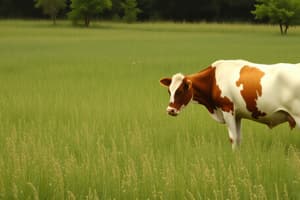Podcast
Questions and Answers
How does forage maturity typically affect its nutritional content for grazing animals?
How does forage maturity typically affect its nutritional content for grazing animals?
- Forage maturity has minimal impact on its nutritional content as nutrients remain constant throughout the plant's life cycle.
- As forage matures, its fiber content decreases, thus enhancing nutrient availability.
- As forage matures, the concentration of readily digestible carbohydrates (NSC) increases relative to structural carbohydrates (SC).
- As forage matures there is a decrease in nutrients (NSC -> SC). (correct)
In what ways does legume forages generally differ from grass forages in terms of animal nutrition?
In what ways does legume forages generally differ from grass forages in terms of animal nutrition?
- Legumes tend to be higher in protein and certain minerals relative to grasses. (correct)
- Legumes are used primarily for silage production, while grasses are used exclusively for pasture.
- Legumes have lower protein and energy content than grasses.
- Legumes are typically lower in calcium and magnesium compared to grasses.
What primary role do Rhizobia bacteria play in pasture or forage systems that include legumes?
What primary role do Rhizobia bacteria play in pasture or forage systems that include legumes?
- Rhizobia decompose organic matter in the soil, releasing nutrients for plant uptake.
- Rhizobia convert atmospheric nitrogen into a usable form for plants. (correct)
- Rhizobia compete with the legume plants for essential soil nutrients.
- Rhizobia inhibit the growth of legumes, preventing them from dominating the pasture.
How do fresh and preserved forages compare in terms of factors affecting their nutritional content?
How do fresh and preserved forages compare in terms of factors affecting their nutritional content?
Why do farmers often rotate crops, particularly incorporating legumes into the rotation?
Why do farmers often rotate crops, particularly incorporating legumes into the rotation?
What is a primary advantage of using continuous grazing versus rotational grazing in pasture management?
What is a primary advantage of using continuous grazing versus rotational grazing in pasture management?
Which characteristic is commonly associated with older forage, affecting its nutritional quality?
Which characteristic is commonly associated with older forage, affecting its nutritional quality?
How do the productivity and soil nitrogen levels relate in forage systems?
How do the productivity and soil nitrogen levels relate in forage systems?
What are the main types of preserved forages?
What are the main types of preserved forages?
What impact does increasing the time animals have to recover plants due to rotational practices have on forage productivity?
What impact does increasing the time animals have to recover plants due to rotational practices have on forage productivity?
Flashcards
Grasses
Grasses
Lower in protein/digestible energy, palatability/nutrition decreases with maturity.
Legumes
Legumes
Higher quality forage, often used for pasture and hay. Examples: Alfalfa, clover, lespedeza.
Rhizobia
Rhizobia
Bacteria in roots convert nitrogen to usable form, enriching soil.
Primary use
Primary use
Signup and view all the flashcards
Fresh Forages
Fresh Forages
Signup and view all the flashcards
Continuous grazing
Continuous grazing
Signup and view all the flashcards
Preserved Forages
Preserved Forages
Signup and view all the flashcards
Nutrition Content factors
Nutrition Content factors
Signup and view all the flashcards
Forage Maturity
Forage Maturity
Signup and view all the flashcards
Study Notes
- Grasses are lower in protein/digestible energy (Co + Mg).
- Palatability/nutrition value decreases with maturity due to lignification.
- Productivity is dependent on the sun and fertilization and on the soil N level.
- Primary usage includes pasture or hay, emphasizing grazing tolerance and growth rate, and also catering to animal and species preferences.
- Legumes are of higher quality.
- Cool-season legumes: Alfalfa, clover, birdsfoot trefoil, and crown vetch are examples of cool-season legumes.
- Warm-season legumes: Lespedeza, forage, soybeans, and peanuts are warm season legumes.
- Legumes are higher in protein, energy, calcium and magnesium.
- Legumes lead to higher performance by grazing animals and are highly palatable.
- Legumes tend to increase fertility in soil.
- High nonstructural carbohydrate concentration in legume stems, also a high nonstructural carbohydrate concentraction in leaves.
- Leaves are the most important part of a legume.
- Rhizobia (bacteria in roots) converts nitrogen into a usable form.
- Rhizobia puts nitrogen back into the soil, explaining crop rotations.
- Legumes primary uses are pasture (as in both grass/legume mixes or legume-only fields) and hay (again, grass/legume mixes or legume-only hay).
Fresh vs Preserved Forages
- Fresh forages are pasture forages.
- Continuous grazing is a type of pasture forage use, rotational grazing occurs and allows for young plants to be grazed, increasing forage intake.
- Continuous grazing maximizes animal productivity with high forage.
- Rotational grazing increases forage productivity, allowing plants recover time.
- Preserved forages include hay, silage, and haylage, hay is baled at a higher moisture content (50%) and sealed/stored.
Factors Affecting Nutrition Content
- Fresh or preserved forages: Fertilization and species selection effect nutrition content.
- Preserving impacts nutritents like rain damage/storage.
Forage Maturity
- Young, leafy forage increases nutrients.
- Nutrients decrease as maturity increases (nonstructural carbohydrates turns to structural carbohydrate).
- Older forage increases fiber and lignin, and it leads to fewer leaves and greater crude protein.
Studying That Suits You
Use AI to generate personalized quizzes and flashcards to suit your learning preferences.



